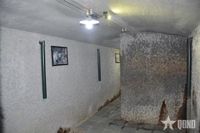A hidden bunker over 100 years old has been discovered near Hoan Kiem Lake in Hanoi, Vietnam, shedding light on the city’s historical resilience during the American war. Located beneath the Northern Electricity Corporation building, this bunker was utilized by electricity workers to avoid bombings during the infamous B52 raids that targeted the North.
The bunker was unearthed in 2019 when the Northern Electricity Corporation undertook renovations of its headquarters. Prior to its discovery, the entire structure lay buried underground and was sealed off, leaving it hidden from public knowledge for decades. Since then, the corporation has cleaned and preserved the bunker, maintaining its original state.
The entrance to the bunker is modest, with a narrow door barely wide enough for a person to crawl through. A sign installed in 2019 at the entrance highlights the historical significance of the site, stating, “The bunker was built around the same time as the French villa (approximately 125 years ago) within the grounds of the Bo Ho Power Plant. No one can forget the American imperialist destruction in the North, where electrical facilities were frequent targets of enemy attacks. Wherever there was electricity, it became a target for the enemy. Hanoi became a hotspot during the American bombing raids.”
As the sign continues, it reflects on the crucial role of electricity during wartime: “Everyone needed electricity; the homeland needed electricity as the body needs blood. As long as the heart of the electricity worker beats, the current will never cease.” Such stirring calls to duty inspired the workers at the Bo Ho Power Plant to bravely confront the dangers of war, ensuring the continuity of power supply for the capital’s residents.
During the American war, particularly between 1968 and 1972, this bunker served not only as a refuge for Bo Ho power plant workers but also as a command post for managing Hanoi’s electricity system. It was a strategic location where workers coordinated efforts to protect the power plant from enemy attacks and quickly restore services after bombings.
The bunker is divided into four sections, featuring two small compartments and two larger rooms, each measuring approximately 6-7 square meters. The two central rooms are over 2 meters wide and nearly 3 meters long, providing a cramped but functional space for those who sought refuge within its walls. The interior walls are thick and sturdy, designed to withstand the impact of bomb blasts.
Access to the bunker is via a narrow staircase comprising five steps, each about 70 centimeters wide, leading up to the surface. Despite its historical importance, the bunker has remained relatively obscure until its recent discovery, prompting discussions about its preservation and potential as a tourist site.
Currently, the Northern Electricity Corporation has designated the bunker as a separate area, enhancing its entrance with stone paving and flower beds. The corporation has also installed lighting and electric fixtures inside the bunker, showcasing photographs that detail the history of the electricity sector in Vietnam, albeit some have faded with time.
Recently, Hanoi authorities announced plans to relocate 12 government offices and 35 households before September 2nd to facilitate the construction of a park in the eastern area of Hoan Kiem Lake, which includes the Northern Electricity Corporation headquarters. This decision has sparked a debate among cultural researchers and historians regarding the fate of the bunker.
Some experts argue that relocating governmental and residential structures is a necessary step for urban development. However, they emphasize the importance of preserving this historical bunker, which serves as a testament to the city’s resilience during the American war. They suggest that the bunker could be transformed into a tourist attraction, offering visitors insight into Hanoi’s wartime history.
As discussions continue, the future of the bunker remains uncertain, but its historical significance is clear. It stands as a symbol of courage and perseverance, reflecting the struggles faced by the people of Hanoi during one of the most tumultuous periods in their history. The hope is that, with the right preservation efforts, this hidden gem can be opened to the public, allowing both locals and tourists to appreciate its rich legacy.
In a rapidly modernizing city, the preservation of such sites is crucial for maintaining a connection to the past. The bunker not only tells the story of the electricity workers who risked their lives but also serves as a reminder of the broader historical context of the American war in Vietnam. As Hanoi continues to evolve, ensuring that these stories are not lost will be essential for future generations.





